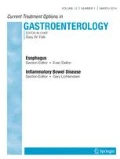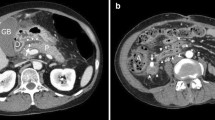Opinion statement
A disconnected pancreatic duct most commonly follows an episode of severe pancreatitis and walled-off necrosis (WON). When the latter is drained percutaneously, a pancreatic fistula connected to an upstream and disconnected duct is commonly seen. Transgastric drainage of WON with or without concomitant percutaneous drainage (dual drainage) will allow placement of two pigtail stents to drain the upstream duct and ultimately allows removal of percutaneous tubes and avoids the need for distal pancreatectomy. These stents should be left in place indefinitely. In patients referred with percutaneous drains and a disconnected pancreatic duct but without a concomitant fluid collection, a combined procedure, in which an interventional radiologist places a TIPS needle into the drain tract to puncture the stomach, allows the endoscopist access to dilate and stent the tract in a manner comparable to pseudocyst drainage. These stents should be left indefinitely, unless subsequent imaging demonstrates atrophy of the disconnected pancreatic tail.


Similar content being viewed by others
References and Recommended Reading
Papers of particular interest, published recently, have been highlighted as: • Of importance •• Of major importance
Kozarek RA, Ball TJ, Patterson DJ, Freeny PC, Ryan JA, Traverso LW. Endoscopic transpapillary therapy for disrupted pancreatic duct and peripancreatic fluid collections. Gastroenterology. 1991;100(5 Pt 1):1362–70.
Varadarajulu S, Wilcox CM. Endoscopic placement of permanent indwelling transmural stents in disconnected pancreatic duct syndrome: does benefit outweigh the risks? Gastrointest Endosc. 2011;74(6):1408–12.
Uomo G, Molino D, Visconti M, Ragozzino A, Manes G, Rabitti PG. The incidence of main pancreatic duct disruption in severe biliary pancreatitis. Am J Surg. 1998;176(1):49–52.
Murage KP, Ball CG, Zyromski NJ, Nakeeb A, Ocampo C, Sandrasegaran K, et al. Clinical framework to guide operative decision making in disconnected left pancreatic remnant (DLPR) following acute or chronic pancreatitis. Surgery. 2010;148:847–56.
Devière J, Bueso H, Baize M, Azar C, Love J, Moreno E, et al. Complete disruption of the main pancreatic duct: endoscopic management. Gastrointest Endosc. 1995;42(5):445–51.
Pelaez-Luna M, Vege SS, Petersen BT, Chari ST, Clain JE, Levy MJ, et al. Disconnected pancreatic duct syndrome in severe acute pancreatitis: clinical and imaging characteristics and outcomes in a cohort of 31 cases. Gastrointest Endosc. 2008;68(1):91–7.
Arvanitakis M, Delhaye M, Bali MA, Matos C, Le Moine O, Devière J. Endoscopic treatment of external pancreatic fistulas: when draining the main pancreatic duct is not enough. Am J Gastroenterol. 2007;102(3):516–24.
Morgan KA, Fontenot BB, Harvey NR, Adams DB. Revision of anastomotic stenosis after pancreatic head resection for chronic pancreatitis: is it futile? HPB (Oxford). 2010;12(3):211–6.
Reid-Lombardo KM, Ramos-De la Medina A, Thomsen K, Harmsen WS, Farnell MB. Long-term anastomotic complications after pancreaticoduodenectomy for benign diseases. J Gastrointest Surg. 2007;11:1704–11.
Tann M, Maglinte D, Howard TJ, Sherman S, Fogel E, Madura JA, et al. Disconnected pancreatic duct syndrome: imaging findings and therapeutic implications in 26 surgically corrected patients. J Comput Assist Tomogr. 2003;27(4):577–82.
Lawrence C, Howell DA, Stefan AM, Conklin DE, Lukens FJ, Martin RF, et al. Disconnected pancreatic tail syndrome: potential for endoscopic therapy and results of long-term follow-up. Gastrointest Endosc. 2008;67(4):673–9.
Sandrasegaran K, Tann M, Jennings SG, Maglinte DD, Peter SD, Sherman S, et al. Disconnection of the pancreatic duct: an important but overlooked complication of severe acute pancreatitis. Radiographics. 2007;27(5):1389–400.
Anderson SW, Soto JA. Pancreatic duct evaluation: accuracy of portal venous phase 64 MDCT. Abdom Imaging. 2009;34(1):55–63.
Soto JA, Alvarez O, Múnera F, Yepes NL, Sepúlveda ME, Pérez JM. Traumatic disruption of the pancreatic duct: diagnosis with MR pancreatography. AJR Am J Roentgenol. 2001;176(1):175–8.
Sherman S, Freeman ML, Tarnasky PR, Wilcox CM, Kulkarni A, Aiesen AM, et al. Administration of secretin (RG1068) increases the sensitivity of detection of duct abnormalities by magnetic resonance cholangiopancreatography in patients with pancreatitis. Gastroenterology. 2014;147(3):646–54. This prospective, randomized controlled trial looking at MRCP imaging with or without secretin demonstrated improved PD imaging with secretin to include visualization of strictures and leaks.
Demirjian AN, Kent TS, Callery MP, Vollmer CM. The inconsistent nature of symptomatic pancreatico-jejunostomy anastomotic strictures. HPB (Oxford). 2010;12(7):482–7.
Banks PA, Freeman ML, Practice Parameters Committee of the American College of Gastroenterology. Practice guidelines in acute pancreatitis. Am J Gastroenterol. 2006;101(10):2379–400.
Nealon WH, Bhutani M, Riall TS, Raju G, Ozkan O, Neilan R. A unifying concept: pancreatic ductal anatomy both predicts and determines the major complications resulting from pancreatitis. J Am Coll Surg. 2009;208(5):790–9.
Oláh A, Romics Jr L. Enteral nutrition in acute pancreatitis: a review of the current evidence. World J Gastroenterol. 2014;20(43):16123–31.
Gans SL, van Westreenen HL, Kiewiet JJ, Rauws EA, Gouma DJ, Boermeester MA. Systematic review and meta-analysis of somatostatin analogues for the treatment of pancreatic fistula. Br J Surg. 2012;99(6):754–60.
Ross A, Gluck M, Irani S, Hauptmann E, Fotoohi M, Siegal J, et al. Combined endoscopic and percutaneous drainage of organized pancreatic necrosis. Gastrointest Endosc. 2010;71(1):79–84.
Gluck M, Ross A, Irani S, Lin O, Gan SI, Fotoohi M, et al. Dual modality drainage for symptomatic walled-off pancreatic necrosis reduces length of hospitalization, radiological procedures, and number of endoscopies compared to standard percutaneous drainage. J Gastrointest Surg. 2012;16(2):248–56. discussion 256–7.
Ross A, Irani S, Gan SI, Rocha F, Siegal J, Fotoohi M, et al. Dual-modality drainage of infected and symptomatic walled-off pancreatic necrosis: long-term clinical outcomes. Gastrointest Endosc. 2014;79(6):929–35. This classic paper reviews 117 patients undergoing dual drainage at a median follow-up of 750 days. There was no surgical necrosectomy, no external fistulas after drain removal, and a 3.4% disease-related mortality.
Arvanitakis M, Delhaye M, Bali MA, Matos C, De Maertelaer V, Le Moine O, et al. Pancreatic-fluid collections: a randomized controlled trial regarding stent removal after endoscopic transmural drainage. Gastrointest Endosc. 2007;65(4):609–19.
Shah RJ, Shah JN, Waxman I, Kowalski TE, Sanchez-Yague A, Nieto J, et al. Safety and efficacy of endoscopic ultrasound-guided drainage of pancreatic fluid collections with lumen-apposing covered self-expanding metal stents. Clin Gastroenterol Hepatol. 2015;13(4):747–52. This is one of the several recently published studies looking at lumen-apposing metal stents to treat walled-off necrosis and other fluid collections. Their long-term placement for disconnected pancreatic ducts cannot be recommended at this time.
Gornals JB, De la Serna-Higuera C, Sánchez-Yague A, Loras C, Sánchez-Cantos AM, Pérez-Miranda M. Endosonography-guided drainage of pancreatic fluid collections with a novel lumen-apposing stent. Surg Endosc. 2013;27(4):1428–34.
Walter D, Will U, Sanchez-Yague A, Brenke D, Hampe J, Wollny H, et al. A novel lumen-apposing metal stent for endoscopic ultrasound-guided drainage of pancreatic fluid collections: a prospective cohort study. Endoscopy. 2015;47(1):63–7.
Irani S, Gluck M, Ross A, Gan SI, Crane R, Brandabur JJ, et al. Resolving external pancreatic fistulas in patients with disconnected pancreatic duct syndrome: using rendezvous techniques to avoid surgery (with video). Gastrointest Endosc. 2012;76(3):586–93.e1-3. This was the index publication of 15 patients with disconnected pancreatic ducts with an external fistula and no residual fluid collections, which described a combined interventional radiologic and endoscopic technique precluding the need for distal pancreatectomy.
Will U, Fueldner F, Goldmann B, Mueller AK, Wanzar I, Meyer F. Successful transgastric pancreaticography and endoscopic ultrasound-guided drainage of a disconnected pancreatic tail syndrome. Therap Adv Gastroenterol. 2011;4(4):213–8.
Findeiss LK, Brandabur J, Traverso LW, Robinson DH. Percutaneous embolization of the pancreatic duct with cyanoacrylate tissue adhesive in disconnected duct syndrome. J Vasc Interv Radiol. 2003;14(1):107–11.
Morgan KA, Adams DB. Management of internal and external pancreatic fistulas. Surg Clin North Am. 2007;87(6):1503–13.
Author information
Authors and Affiliations
Corresponding author
Ethics declarations
Conflict of interest
Michael Larsen declares that he has no conflict of interest. Richard A. Kozarek declares that he has no conflict of interest.
Human and animal rights and informed consent
This article does not contain any studies with human or animal subjects performed by any of the authors.
Additional information
This article is part of the Topical Collection on Pancreas
Rights and permissions
About this article
Cite this article
Larsen, M., Kozarek, R.A. Management of Disconnected Pancreatic Duct Syndrome. Curr Treat Options Gastro 14, 348–359 (2016). https://doi.org/10.1007/s11938-016-0098-7
Published:
Issue Date:
DOI: https://doi.org/10.1007/s11938-016-0098-7




